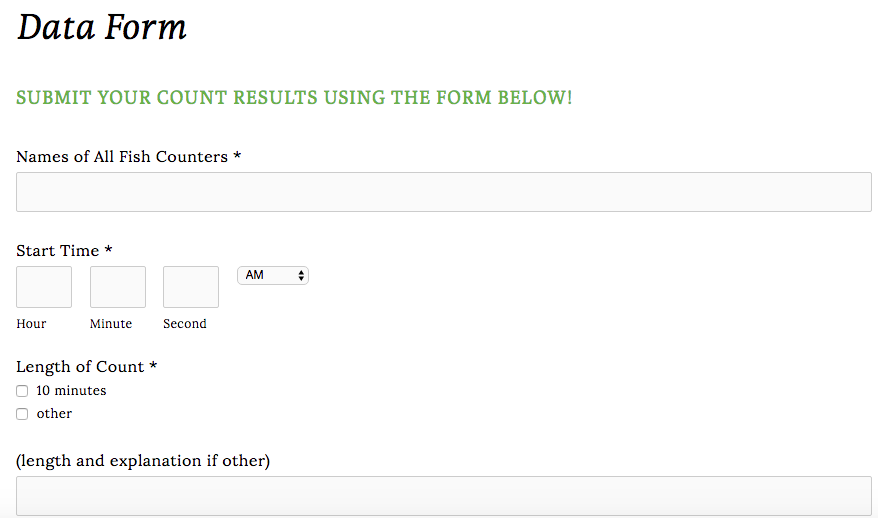COUNTING INSTRUCTIONS
Each volunteer signs up for a 2 hour period of time. We ask that you count alewives for two 10 minute periods in that 2 hour block. Your 10 minute counts can be spaced out however your would like within the 2 hours.
Note: Counting takes place at the last place where the fish need to climb up a slope of moving water before reaching the lake. This can be a flat or v-shaped board depending on the lake water levels. Please count the fish when they finish the climb and enter into the still water above.
Count location with higher lake water levels.
Count location with lower lake water levels.
Detailed Instructions
Go through gate in the fence to access the top of the dam where the fish count takes place.
If the surface of the dam is wet from rainwater or water from the lake flowing over the dam surface, it may be slippery. Safety is most important! Please feel free to skip your fish count if the dam surface is wet. It is helpful if you can send an email to rindrick@kennebecestuary.org with information about the conditions.
Read air temperature (F) from the thermometer attached to the fence, then read water temperature in Nequasset Lake using the thermometer floating in the water that is attached to fence by a cable.
On your sheet of paper, on the 2025 online data form, or on an email in your phone, record the water temperature (F), air temperature (F), weather code, and any brief comments about the weather or predators (such as seagulls, seals, etc.). See the observation section below for more comment suggestions.
Note! Volunteer Livy Glaubitz put together a printable simple check sheet. Everything's in the same order as the online form, so it’s easy to transfer your field notes to the form. Click here to access this check sheet in case you want to print it out to have during your count.
Find a comfortable position with a good view of the final v-notch weir, just before the dam meets the lake.
Check your watch, write down the times you will start and end your 10 minute count (e.g. 14:17-14:27 or 14:55-15:05). If available, set a 10 minute timer on your watch or phone.
Start counting! Record each time a fish passes over the weir and enters all the way into the still water of Nequasset Lake.
You can record each fish that goes by using tally marks on a sheet of paper
or
You can use an app on your phone to record each fish that goes by. See some options below.
Tips for Counting
If you don’t see any fish during a 10-minute count, write down 0 fish. This is important data!
Please don't count any fish that are exiting the lake (mentioning them is a great comment!). Fish often exit the lake tail first.
A nearby fish ladder that tagged fish a few years ago is tracking where they go this year. If you see a fish with a small blue plastic tag sticking out of its back, please note it in the comments section.
When 10 minutes is up, record the final number of fish on your sheet of paper or on the 2025 online data form.
Submit the 2025 online data form from your phone in the field - or - type your results into the 2025 online data form when you’re back at your computer and submit it there - or - email your results to rindrick@kennebecestuary.org.
Suggestions
Polarized sunglasses may help you see the fish better.
To avoid spooking the fish, stand still, and try not to cast a shadow on the stream.
In late May and early June, if you see fish sliding backward down the ladder, these fish are probably exiting the lake. Fish exit the lake tail-first. Please don’t include these fish in your count but do make a note of them in the notes section of your datasheet.
If one of the thermometers is missing or you have any questions that need answers immediately, please call Ruth at 315-415-4160.
Other Observations
Other observations are welcome and often useful. Examples of potentially useful observations are:
Condition and function of the fish ladder
Other fish (e.g., American eels, bass etc.)
Estimated numbers of herring downstream or upstream of the counting site, even if they have not passed you during your count period
Fish behavior (e.g., schooling, milling about, heading upstream or downstream, not passing through the ladder, etc.)
Number of fish going down the ladder - returning to the sea after spawning
Numbers of seagulls or other predators or fishermen
Other observed animals
Water quality, color of water
Height of water relative to some marker
Juvenile fish
Spawning in the run or stream itself (likely to be Blueback herring rather than Alewives, which prefer to spawn in ponds)
Other










